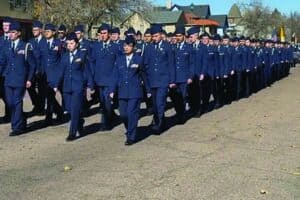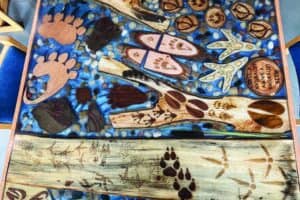This year, thousands of firefighters have battled massive wildfires in the United States. Again. The all-too familiar images on TV and social media showed walls of fire ravaging forests and communities, with aircraft dropping swaths of red fire retardant or scooping water from lakes.Although fire aviation resources play key roles in fighting wildfires, much of the work is carried out by literal ìboots on the groundî ó wildland firefighters armed with hand tools, chainsaws, and gritty determination. These men and women are a diverse lot, representing a variety of ethnicities, backgrounds and skills. But whether they fly, drive or hike into fire zones to do their jobs; and, regardless of the agency they work for, wildland firefighters are united in a common goal: protecting lives, property and natural resources. Firefighting is a team effort.Wildfires, which the fire service calls wildland fires, have not been as widespread and destructive this year in Colorado as they have been in previous years, but they have dominated the headlines elsewhere. The West Coast, the Pacific Northwest and the Northern Rockies have all experienced devastating and deadly wildfires. As of Sept. 21, 51,606 wildfires have burned 6,815,741 acres across the U.S., according to the National Interagency Fire Center (NIFC).Wildfires have become larger, more frequent and more widespread across the U.S. since 2000, according to an analysis published in March 2022 by the Cooperative Institute for Research in Environmental Sciences at the University of Colorado Boulder. Scientists predict that trend will only continue with the worsening effects of climate change.Who fights wildland fires?Locally, municipal and rural firefighters respond to wildland fires within their jurisdictions, but they also help out other agencies under mutual aid and automatic aid agreements. According to the El Paso County Sheriffís Office website, paid and volunteer wildland firefighters comprise the El Paso County Wildland Fire Management team, which responds to wildfires in the county and surrounding areas as well as assisting state and federal agencies. The Colorado Springs Utilities Catamount Wildland Fire Team responds to wildfires occurring on CSU property or watersheds, and also supports local fire departments, according to the CSU website.The Colorado Division of Fire Prevention and Control (DFPC) is the lead state agency for fire. DFPC maintains aviation and ground firefighting assets based around the state that can assist local fire agencies year-round. Per the DFPC website, ground resources include six engines staffed with four firefighters each and five firefighting modules (including one based in Colorado Springs) that are each staffed with seven to 10 wildland firefighters.At the federal level, the U.S. Forest Service (USFS), U.S. Fish and Wildlife Service, Bureau of Land Management, Bureau of Indian Affairs and National Park Service all employ permanent and seasonal wildland firefighters. This term is used broadly because they are trained in the tools and methods used to fight wildfires. However, some wildland firefighters are known by different names because of their specific skill sets. The following descriptions were compiled from the National Wildfire Coordinating Group (NWCG) and USFS websites.Hand crews: Organized crews of 20 people who use specialized tools, equipment and techniques to construct fireline around a wildfire.Engine crews: Three to five firefighters who staff heavy-duty, off-road wildland fire engines. These vehicles can carry up to 800 gallons of water in addition to crew, equipment and supplies.Hotshots (Interagency Hotshot Crews): Highly trained, experienced and skilled wildland firefighters who may deploy across the country to fight wildfires. The first Hotshots were established in California in the 1940s and received their name because they worked the hottest parts of a wildfire.Combining elements of both fire aviation and ground firefighting operations, Helitack crews use helicopters to fly into fire zones. They can perform an initial fire attack, transport equipment and supplies and deploy the helicopterís water bucket. Helitack firefighters are also trained to rappel from helicopters into remote areas where terrain or vegetation prevents the aircraft from landing. Smokejumpers parachute into remote and inaccessible areas to provide a quick initial fire attack on wildfires.More than firefightingIn addition to the different categories of wildland firefighters, various non-firefighter personnel support wildfire suppression and management efforts. These can include dispatchers, incident management teams, logistics and finance personnel, fire aviation support, fire investigators, and more.Lola Long, a business operations staff officer with the U.S. Forest Service, explained that qualified USFS employees can deploy as single resources to wildfires. ìAnyone who has the training can assist us on an incident,î she said. Some may work as firefighters while others operate in a support capacity. For example, an employee whose primary job is in logistics or purchasing can apply those same skills while assigned to a wildfire incident. Some support personnel no longer have to deploy to a physical site. Like everyone else, USFS had to follow pandemic protocols and transitioned to remote operations for many tasks. ìCOVID made us adapt,î Long said. Agency leaders have since decided to keep some remote work options in place.Jennifer Myslivy, public affairs specialist for the Bureau of Land Management at the National Incident Fire Center in Boise, Idaho, also noted the increase in virtual work options. She said that remote workers were ìvery productiveî during the pandemic, and were able to protect their health while still performing critical functions. Now some jobs, such as positions in fire planning and contracting, are offered with remote options. Myslivy said that the Incident Management Team assigned to the Moose Fire near Salmon, Idaho used virtual positions in the public information section. (The Moose Fire was still active as of Sept. 21.)What it takes to be a wildland firefighterThe NWCG publication ìA Preparedness Guide for Wildland Firefighters and Their Familiesî describes wildland firefighting as hazardous work that can include ìarduousî hikes carrying as much as 100 pounds of gear. Physical fitness is paramount. A basic measure of fitness for firefighters working for federal agencies is the Work Capacity Test (WCT), in which a person must walk three miles in 45 minutes while carrying a 45-pound pack. Hotshots, Helitack and smokejumpers must meet more stringent fitness standards due to the extreme nature of their duties.Another federal requirement is the Incident Qualification Card, commonly referred to as a ìRed Card.î Part of the interagency Incident Qualification and Certification System (IQCS), this document certifies that a person is qualified to fill certain positions at an incident. Standards are set by NWCG and cover training, experience, and physical fitness.Wildland firefighters must be physically and mentally prepared for long, demanding hikes while carrying fire packs, tools and chainsaws; digging miles of fireline; moving brush, trees and rocks; and using chainsaws to fell trees. Conditions are typically hot, smoky and dusty. Work is often performed in remote areas with no cell service; communications are done via radio or face-to-face. A work day can last 16 hours, and there is little downtime during deployments.Hazards of wildland firefighting include falls, burns, smoke inhalation, cuts, noise exposure, lightning and more. On average, 17 firefighters die in wildland fire-related operations each year, according to statistics from the U.S. Fire Administration and NWCG. In 2021, 23 wildland firefighters died in the line of duty; nine have been killed so far in 2022. NWCG states that the most common causes of death continue to be medical emergencies, vehicle accidents, strikes from falling objects such as hazard trees, and fire entrapments or burnovers.Additionally, the work can take a toll on mental health. NWCG and its member agencies have already developed, and actively promote, resources to help wildland firefighters manage stress and burnout, and build resilience. The Bipartisan Infrastructure Law signed in November 2021 by President Joe Biden provides funding for the Department of the Interior to improve mental health resources for wildland firefighters.Rewarding career opportunitiesVidalia Vigil, a USFS Fire Prevention Specialist for the Pike-San Isabel National Forests, described some of the best things about being a wildland firefighter: being outdoors, every day being different, the challenge and excitement of fighting fires. Each fire provides ìthe potential to learn new lessonsî that can be applied to future incidents. Vigil said her attitude toward continual learning is one that is shared by the USFS as it continues to adapt to new technologies and evolve in a rapidly changing natural world. Todayís extreme fire environment makes it challenging to meet ìour basic goal of managing the land in a healthy way,î she said.Myslivy also prefers being outside to sitting behind a desk and enjoys working to protect public lands and communities for future generations. Deployed to the 2020 Creek Fire in California, she was one of many working to protect the giant sequoias, which she called ìnational treasures.îBoth Vigil and Myslivy mentioned the career opportunities available within federal agencies. Vigil is nine years into her career, serving as a wildland firefighter for more than half of that time before moving into a community outreach and education role. She said it is important for people to understand the opportunities that USFS jobs can provide, especially in smaller communities. Myslivy is a 26-year veteran who also worked as a wildland firefighter before moving on to positions in dispatch, prevention, community outreach and public affairs. For employees seeking improved work-life balance in the wildland fire community, ìThere are opportunities outside of being on an engine or a Hotshot crew,î she said.Individuals who are interested in becoming wildland firefighters at the local or state level will need to check job postings for the specific agency in which they are interested. Vigil and Myslivy said that October is typically when federal agencies begin accepting applications for seasonal firefighters. To find federal wildland firefighting job postings, go to usajobs.com and enter search terms such as ìwildland firefighter,î ìfirefightingî or ìforestry technician.î






